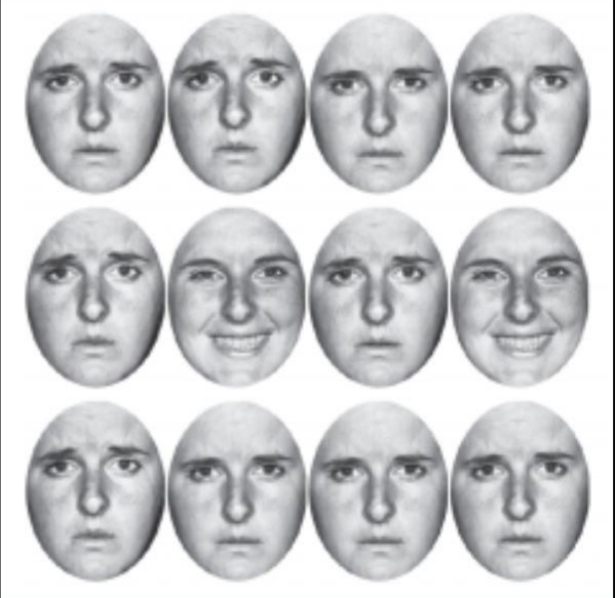Lecture 04: Brain Development and Sensation and Perception
1/81
There's no tags or description
Looks like no tags are added yet.
Name | Mastery | Learn | Test | Matching | Spaced |
|---|
No study sessions yet.
82 Terms
What percentage of zygotes successfully complete the germinal stage of development?
a) 0%
b) 25%
c) 50%
d) 75%
e) 100%
25%
Which of the following is/are incorrect?
a) Lanugo is a white, cheesy covering that helps prevent chapped skin.
b) Vernix is a fine layer of body hair to help the lanugo cover the body.
c) The age of viability is between 22 and 28 weeks.
d) The fetus’ movement may be felt by the mother for the first time in the 4th to 6th months of pregnancy.
e) Two of these options are incorrect.
f) All of these options are incorrect.
Two of these options are incorrect.
A and b (definitions are mismatched)
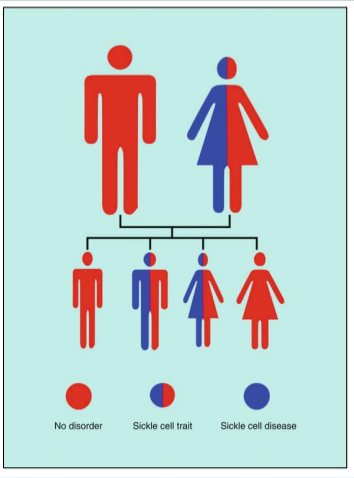
Roxanne is heterozygous for sickle cell anemia. If she has offspring with a homozygous partner who does not have sickle cell anemia, what is the likelihood that Roxanne’s offspring will have sickle cell anemia?
a) 0%
b) 25%
c) 50%
d) 75%
e) 100%
0%
No homozygous recessive children (sickle cell anemia is recessive) none of the children will have sickle cell disease
They will have sickle cell trait (different than sickle cell disease) but thats not what the question is asking
Germinal stage
1st stage of prenatal development
0-2weeks (conception until implantation to the uterine wall)
The embryonic stage
occurs from 3-8 weeks gestation.
During this stage, rapid development occurs.
Major organs develop! In fact, all major organs are formed and the heart begins to beat!
During this stage, the embryonic disk differentiates into three cell layers:
Ectoderm
Mesoderm
Endoderm
Ectoderm
becomes nervous system, skin & hair.
Outside layer of embryonic disk
Mesoderm
becomes the muscles, bones and circulatory system.
Endoderm
becomes the digestive system, lungs, urinary tract, and other vital organs.
The Neuron
are the basic units of the brain.
Transmit electrical and chemical signals across synapses (space between the dendrites).
Most formed by end of second trimester (end of 6th month).
Structure of the neuron
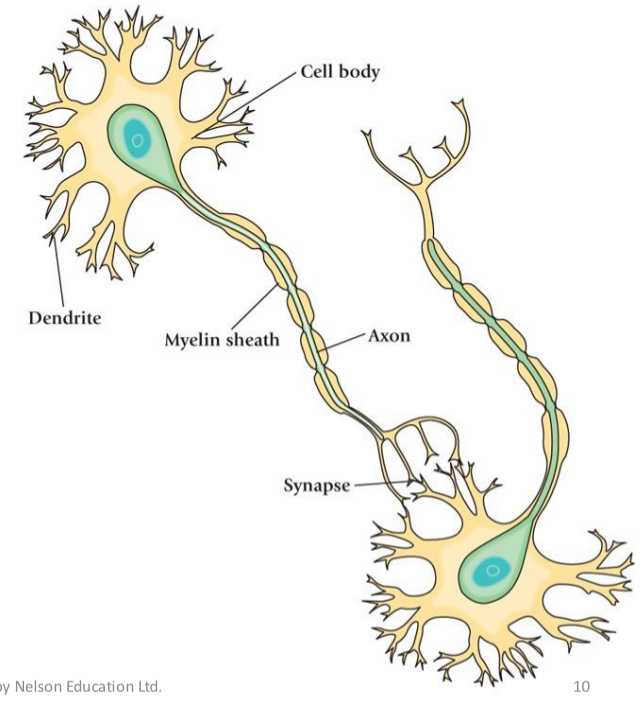
Brain Growth Spurt
Beginning 7 months gestation and lasting to 2 years of age.
Brain weight increases dramatically from 25% of its adult weight (at birth) to 75% of its adult weight (by age 2).
What accounts for brain growth?
Myelination
Synaptogenesis
Glia cells
are a type of nerve cell and major contributor to brain growth.
more numerous than neurons.
serve supportive functions, including:
Nourishing cells.
Facilitating transport.
Managing debris and waste removal.
Oligodendrocytes
a type of glia cell
encases neurons in insulating sheets called myelin.
Myelinization:
process of coating neurons with myelin sheath.
Myelin sheath acts as an insulator to speed the transmission of neural impulses along the axon of the neuron.
Allows brain to communicate more efficiently with the rest of the body
Sensory pathways to brain myelinated at birth.
Frontal cortex is not fully myelinated until adolescence or early adulthood
At 25
Also part of the reason why toddlers get distracted or bored with one thing very quickly
Ex. If you asked a 1 year old vs 2 yr old “what’s 2+2” the 1 yr old will take more time to answer partly because they don’t have as much myelinization, meaning it takes longer to process info
Increased myelination = enhanced motor ability, attention span, information processing
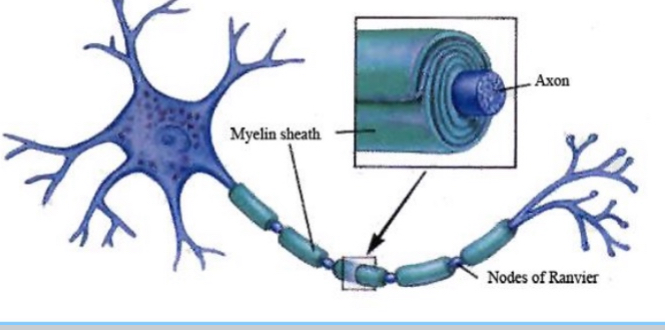
Which direction does myelination occur
cephalocaudal
proximal distal
cephalocaudal
“Top to bottom”
Things at top of head get myelinated before things further away from head
proximal distal
Myelination will occur first at things at centre of body before things further away from body
Synaptogenesis
Recall, neurons transmit information via synapses.
Synaptogenesis (formation of synaptic connections) proceeds rapidly.
Infants when born will have more neural connections than adults do
So half of neurons that are formed when child is young also die when child is young
Brain plasticity—the brain is shaped by experience.
E.g., Synaptic pruning (refers to the refinement and elimination of neurons).
Getting rid of neurons that are not used
Starts at time of birth and ends at sexual maturation
Neurons and synapses that are most often stimulated continue to function.
If you don’t use it, you’ll loose it

Perceptual Narrowing
Babies are very good at discriminating different stimuli
Babies are born as “citizens of the world” and become culture bound perceivers.
Babies can be born anywhere in the world and learn the language of that place no matter their ethnicity
Can’t do that with an adult
Perceptual Narrowing: increased sensitivity to frequently encountered stimuli and reduced sensitivity to infrequently encountered stimuli.
We will be good at stimuli we frequently increase
Synaptic pruning may lead to perceptual narrowing

What path does perceptual narrowing follow?
X axis :
prenatal (before birth )development is left of dotted line
Postnatal (after birth) development is right of dotted line
y axis: how good is relative discriminability (perceptually between different stimuli)
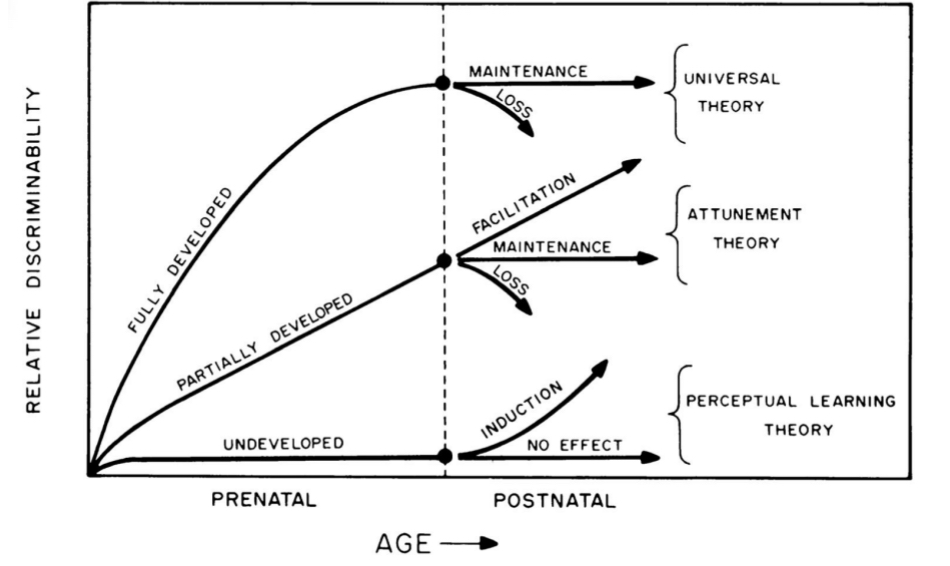
3 theories for perceptual narrowing
Universal theory
Attunement theory
Perceptual learning theory
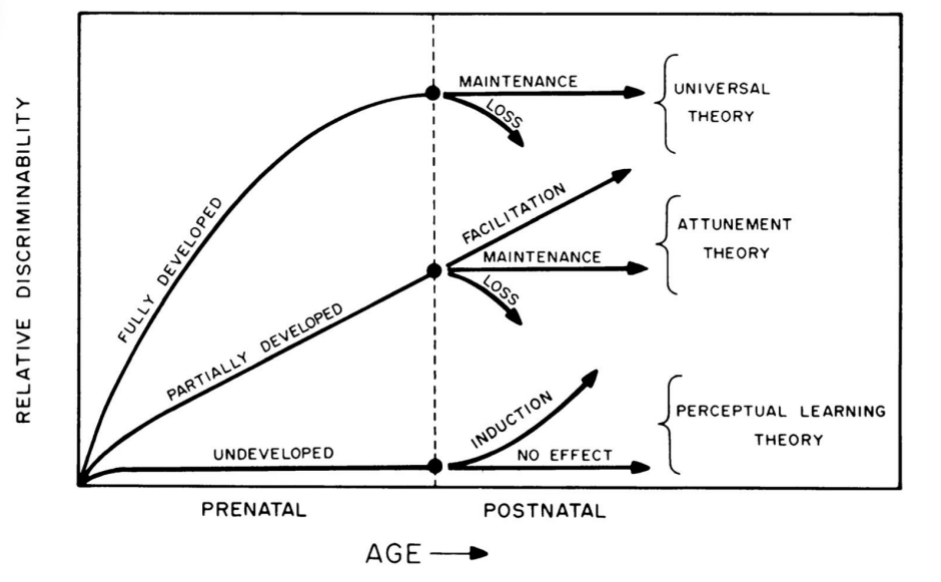
Universal theory
Thought to be the answer when it was proven that infants are actually outperforming adults ability to discriminate between different stimuli
Perception discrimination abilities are fully developed prenatally, and after birth we need exposure to maintain abilities
If we don’t get exposure, abilities will be lost
Attunement theory
Data today supports this theory the most
We have partially developed perceptual discrimination, and after birth they can either be facilitated, maintained, or lost
If we don’t have experience: lost
If we have some experience: maintained
Emerson and exposure : facilitation and enhancement of perceptual abilities
Perceptual learning theory
When infants are born, they have underdeveloped perceptual ability
Only through induction they will increase perceptual discrimination skills
After birth they need exposure to strengthen this skill
If they don’t get exposure, they won’t get perceptual discrimination ability
Experience was the answer until it was proven that infants are actually outperforming adults ability to discriminate between different stimuli
Universal theory was born
Development of the Brain
Not all parts of the brain develop at the same rate.
At birth, the most highly developed areas are the subcortical brain centers.
Lower brain centres
Control reflex’s and biological function (digestion, respiration and elimination)
These brain structures located deep in brain and include pituitary gland, limbic structure and basal ganglia
Surrounding structures are cerebrum and cerebral cortex (impacted by voluntary bodily movement, perception, higher intellectual activities like learning, thinking and production of language)
The first areas of the cerebrum to mature are the primary motor areas (waving of arms) and primary sensory areas (vision, hearing, smelling, tasting)
Piagets first stage of cognitive development had to do with primary sensory areas because this is what they are good at birth and the first to develop
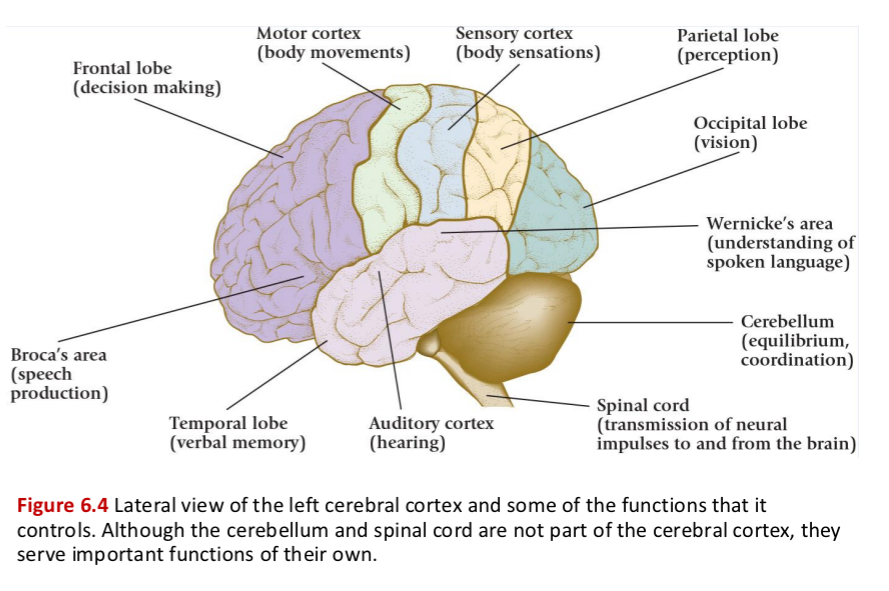
At 6 months newborn reflexes
Disappear
This is because the higher cortical centres of brain or getting control over more primitive more subcortical areas of brain
Frontal lobe
Decision making
motor cortex
Body movements
Sensory cortex
Body sensation
Parietal lobe
Perception
Occipital lobe
Vision
Wernickes area
Understanding spoken language
Cerebellum
Equilibrium coordination (balance and posture)
Spinal cord
Transmission of neural impulses to and from the brain
Auditory cortex
Hearing
Temporal lobe
Verbal memory
Broncos area
Speech production
Diagram of brain NEED TO MEMORIZE

The Anatomy of the Brain
The cerebrum consists of 2 hemispheres connected by the corpus callosum (band of fibres)
Each of the hemispheres is covered by a cerebral cortex.
Outer grey matter layer that controls sensoral and motor processes, perception and intellectual functioning
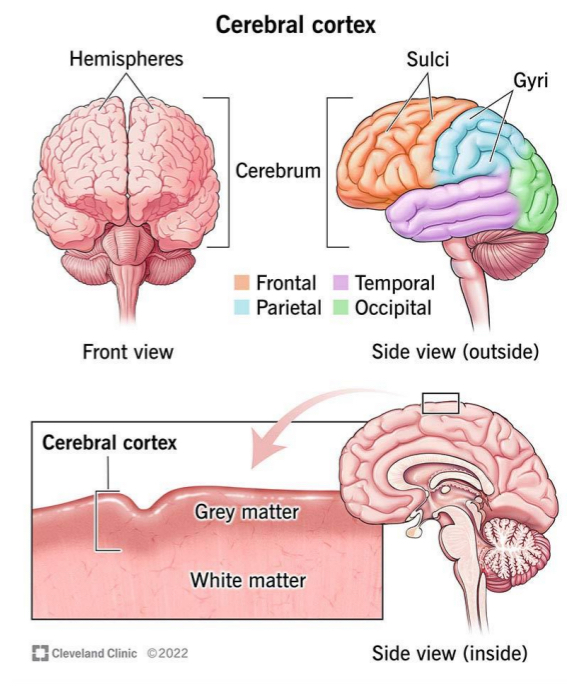
Left hemisphere
Control right side of body
centres for speech, hearing, verbal memory, decision making, language processing and expressing of positive emotion
Right hemisphere
Controls left side of body
Centres for visual and spatial processing, nonlinguistic sounds (music), touch sensation and expression of negative emotion
Cerebral lateralization
is the specialization of brain functions in the left and right cerebral hemispheres.
occurs during the prenatal period.
What evidence do we have for this?→ preference for one side of body over the other)
Nero imaging tech
Some behavioural evidence: 2/3 fetuses end up positioned in womb with right ear facing outward. Gives them a right ear advantage and leads us to think that left hemisphere is for language processing
Speech sounds stimulate more brain activity in left hemisphere than right
Newborns turn to right then left when they lie on back. And later they will reach for objects with right hand
By birth, the brain is not completely specialized.
Specialization happens throughout childhood (e.g., handedness (right vs left) is established by 2 years of age).
9/10 adults will be right handed
32% of preschoolers will prefer one side of body
More than half of adolescence will rely on one side of body
A neonate is born with _____ % of an adult’s brain and develops to _____% by 2 years of age through the brain’s growth spurt.
a) 25; 75
b) 30; 60
c) 50; 75
d) 50; 100
e) 25; 50
a) 25; 75
Michael thinks that his baby is born with all of their discrimination abilities and will either maintain or loose these abilities based upon the input received. What theory does Michael believe discrimination abilities follow?
a) Attunement Theory
b) Universal Theory
c) Perceptual Learning Theory
d) Perceptual Narrowing Theory
b) Universal Theory
Newborn Reflexes
Survival Reflexes
Primitive Reflexes
Indication of brain development
Survival reflexes
Needed for basic function
Breathing , sucking and swallowing
Rooting reflex
Rooting reflex
Side of check stroked, baby turns head to direction of stimulus
Great for feeding purposes. Help infant search for food and find something to suck on
sucking and swallowing Reflex
Pressure at top of infants mouth, they will suck
Good for feeding, when nipple or bottle enters their mouth they know to suck at get food
Also positive reinforcement for caregiver who sees baby soothed, and helps with bonding process
Primitive reflexes
No adaptive or survival important
Remnants of evolutionary history that were useless at one point in time, not anymore
Controlled by subcortical part of brain
Gradually disappear at 1 yrs old especially at 6months, sign of higher brain development
Grasping or babinski reflex
Babinki reflex
Stoke bottom of baby foot, the toes will fan out and curl back
Not sure why this exists or was once useful
Grasping reflex
Put your finger in babies palm, they will grasp finger
Not sure why this exists or was once useful
How are reflexes connected to brain development
By 6 months, reflexes have disappeared indicating that higher cortical centers are assuming proper control over the more primitive subcortical areas of the brain.
Lingering of primitive reflexes is a sign of problem
If you stroke the bottom of a baby’s foot, what do you expect to happen and what is this reflex called?
a) The baby’s toes will curl; Babinski reflex.
b) The baby’s toes will bend back; Rooting reflex.
c) The baby’s toes will fan out; Babinski reflex.
d) The baby’s leg will kick; Rooting reflex.
e) The baby’s toes will be tickled.
c) The baby’s toes will fan out; Babinski reflex.
Sensation
Information received by the sense organs
i.e., brain receives input from the eyes
Perception
Interpretation of the information received from the sense organs
i.e., brain makes sense of the input received from the eyes

Sensation & Perception: Illusions
Example 1: we all see the same picture, but some people perceive dancer spinning clockwise, counterclockwise or both
Example 2: we all see same picture (sensation) but some people perceive young lady, old lady or both

Jen sees this image as a grey and green shoe, whereas John sees it as a white and pink shoe. This is an example of differences in their _____ of the shoe.
A. Sensory understanding
B. Sensation
C. Visual processing
D. Perception
D. Perception
Early Controversies
Nature vs nurture
Enrichment vs differentiation
Is reality simply “out there” to be detected by our senses? OR Do we construct our own interpretations of reality based on our experiences?
Nurture
William James
Newborn as a blank slate (tabula rasa)
Learn to interpret sensations
Nature
Descartes and Immanuel Kant
Perceptual abilities are innate
i.e., Born with an understanding of spatial relations (objects far away look smaller and get bigger as they move closer)
Enrichment Theory
Cognition enriches sensory experience
Our knowledge helps construct meaning from sensory stimulation
We have to use cognitive schemas that we already have to make sense of world
Ex. People that can identify the song after one or two notes. They use the already existing schema (or memory of that song) to answer correctly
Differentiation Theory
Detecting distinctive features allows for discrimination between experiences
Everything is already there in object, but we have to take features from that object to help us understand how it is different from another object
All information we need is present in sensory environment, all we have to do is detect distinctive features
Ex. When children use the word”dog” to refer to every small furry creature. As they grow older they can differentiate between different animals (bunny and dog)
Development of Perception: Timeline (order in quickest to slowest to mature)
taste, smell, touch
Hearing
Vision
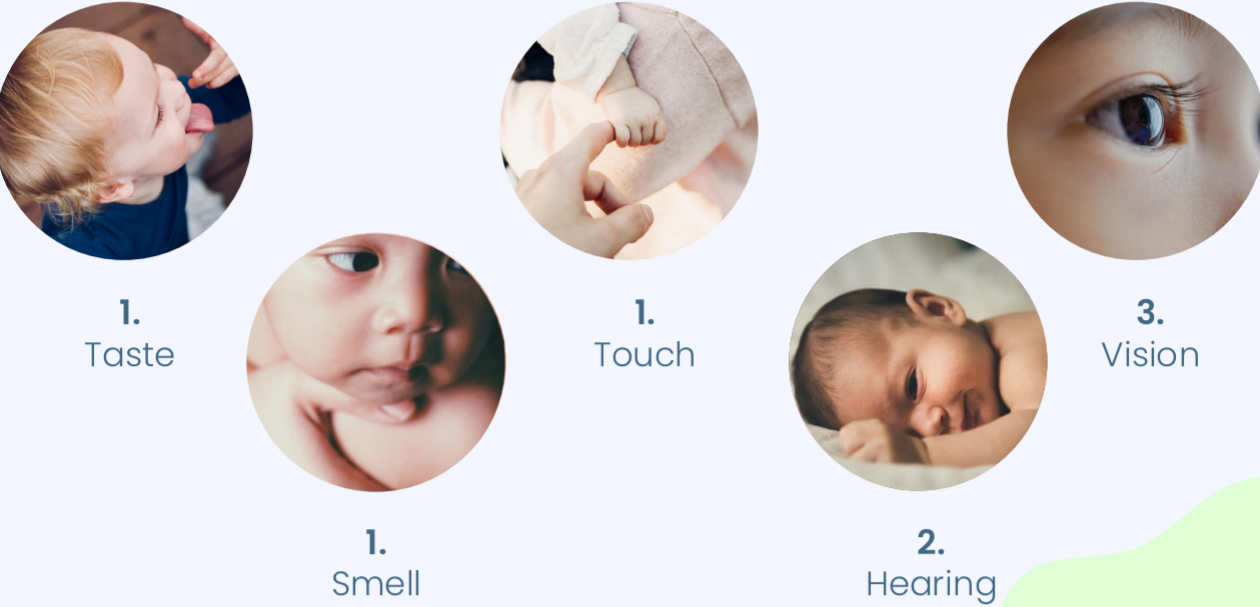
Taste
Highly developed at birth (even in utero)
Taste preferences at birth - sweet tooth
Newborns found to suck faster and longer for liquids that are sweet opposed to other tastes
Elicits different facial expressions (even in infants at 2 hrs old)
Sweet → pleasant expression
Sour → pleasant expression
Smell
Present very early
Facial expressions of disgust
Preference for the odor of milk to that of amniotic fluid as early as 4 days after birth
Discriminates own mother from other women at 1-2 weeks old based off the smell of mother’s breast and armpits
Touch
Developed in the womb
Grasping of umbilical cord, thumb sucking
Therapeutic benefits of touch → lower stress level and help promote healthy neural activity
Develops earliest around mouth, then palm of hands, and soles of feet to explore environment
Sensitive to temperature and pain (even 1 day old infant will cry to needle)
Benefits of skin-to-skin contact Reduces infant crying by 82% in response to pain like needle
Hearing
1st few hours of life, baby hearing is as good as an adult’s with a cold. Could be because of fluids that got in ear during birth
Newborns can discriminate sounds that differ in:
Loudness, duration, detection & frequency
Hearing improves in 4-6 months
Newborns can discriminate mother’s voice
Prenatal learning influencing neonatal preferences
Baby will suck faster to hear recording of their mothers voice as opposed to voice of another women
Baby will also suck faster when mother repeats a passage that she read to baby while pregnant
At birth, more developed than visual ability
Can be disrupted by otitis media
otitis media
Bacterial infection in middle ear may produce mild to moderate hearing loss that can last months
6 months - 3 yrs old hit the hardest
Mostly found in infants and preschoolers in canada
75% of children affected at least once, reoccurrence is common
Developmentalists thought reoccurring infections will affect child’s ability to understand another persons speech Which will further harm their ability for their overall language development and social and cognitive skills
Vision
Least matured sense at birth
However sensitivity to light
Can track stimulus with eyes if it moves slowly enough
Visual acuity of 20/400 → legally blind
Have trouble bringing stimuli into focus
Reaches adult level at 12 months old
More likely to track with eyes and head stimuli of faces than other objects
Newborn preference for their mother’s face
2-3 months -> basic colour discrimination
4 months -> grouping shades into colour categories
Light blue and royal blue are both blue
How Can We Study Infant Perception?
Preference method
Video coding
Eye tracking
Habituation Method
Discriminable stimuli
High Amplitude- Sucking Method
Preference abilities
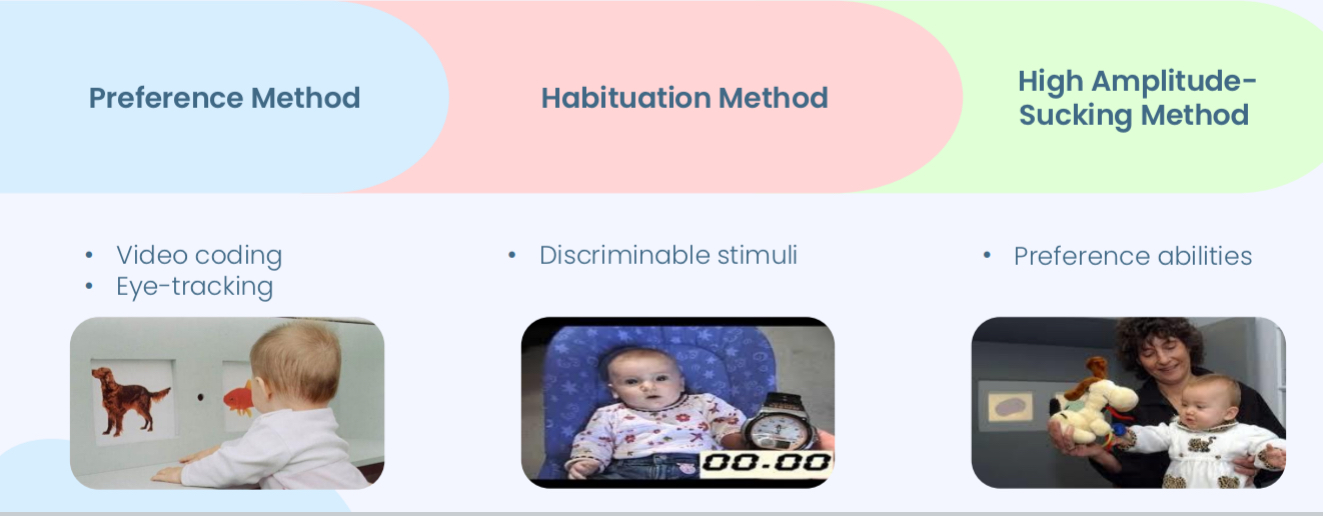
Preference Technique
Preference for one stimuli over another
Are the two stimuli discriminable? (Can they tell stimuli apart)
Is one stimuli preferred more than the other?
Fantz’ Looking Chamber (1956)
Video coding, eye-tracking (used today)
Video coding : record baby face when they look at stimuli, human watches recording and sees which stimuli baby looked at for longer
Eye tracker : live tack pupil movement and tell us where child was looking

Fantz’ Looking Chamber
Infants placed on back and shown 2 stimuli
Observer hovering over and recording how much time infant spent looking at each stimuli
If they looked at one stimuli over the other, that stimuli was more favourable
Faces looked at longer than other stimuli
Preference Technique: Sounds
Record their looking time to pictures for audios that play different sounds
Infant directed-speech (how you talk to baby→ baby voice) versus adult-directed speech (normal voice)
Infants looked at picture that corresponded with Infant directed-speech longer showing favour ability
Shortcoming with using Preference Technique
If baby showed no preference to stimuli, we don’t know if thats because they failed to discriminate stimuli or if they found both stimuli to be equality interesting
Habituation
Less and less attention directed to a stimulus that has become familiar through repetition
Dishabituation
Increase in attention that occurs when a stimuli changes
Habituation Method
Baby is repeatedly shown same stimuli over and over and then interest in that stimuli decreases because they are familiar with that object
Interest in object measured by head or eye movements, change in respiration or change in heart rate
Baby recognizes that they’ve seen something before, and so they have less interest or attention towards that
Researcher do this by
Show baby same object a lot until they show decreased interest (habituation)
Then introduce new stimulus
if infant can discriminate between the 2, they will dishabituate when looking at new stimulus (show interest and increased attention)
Willow is a 6-month-old infant, she is shown a blue-coloured card repeatedly. If the colour of the card is now changed to green, and Willow displays increased interest, what can we infer?
A. Willow is not able to perceive the difference between the two cards.
B. Willow can perceive the difference between the two cards.
C. Willow prefers the green card to the blue card.
D. Willow prefers the blue card to the green card.
B. Willow can perceive the difference between the two cards.
High-Amplitude Sucking Method
Examining infant discrimination and preference abilities
Birth – 4 months old
Based on variation in the rate of sucking on a special pacifier
Special pacifier has some electric circuitry
Researchers need to determine baseline sucking (what rate does baby normally suck at)
Then when baby sucks faster, the pacifier will introduce a new stimuli
If baby find this stimuli interesting they can make it last longer by displaying bursts of high speed sucking
When baby is no longer interested, sucking will return to baseline, and stimuli from projector will go away
Ex. High amplitude triggers mothers voice, low amplitude triggers stranger women voice. If baby continues to engage in high amplitude sucking, we can infer they prefer their mother’s voice
Usually only used for sound stimuli because at 4 months vision is not as developed
Ensemble perception
Ability to extract summery information from complex scenes
Reduces cognitive load because it would be lots of effort to notice every emotion
We can extract what the average emotion is, for example in this pic, average emotion is confused, even though there are a few happy faces
